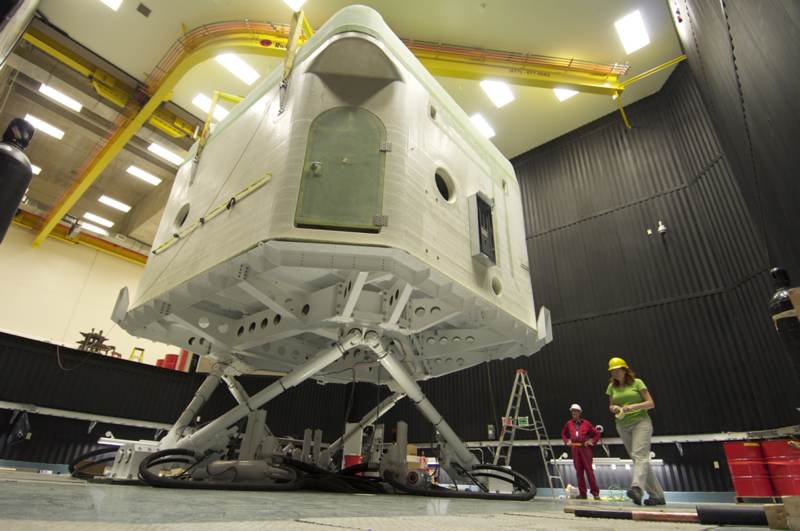
This motion simulator platform is one of many technological advancements to be seen in the Toronto Rehab Institute's Challenging Environment Assessment Lab (CEAL). Courtesy S.K. Advani
By Melissa Sundardas
The new subterranean research lab on University Avenue is bringing a scale of advanced, breakthrough technologies for research that would make Willy Wonka proud.
Located just beneath Toronto Rehab Institute’s University Centre (550 University Ave.), this new facility—called the Challenging Environment Assessment Lab (CEAL)—allows scientists to safely and accurately develop treatments, technologies, and products that will help the elderly and disabled cope with everyday difficulties, especially during the winter. The facility will be ready to begin experiments in March.
“Sometimes it’s quite difficult to go straight from the laboratory into the real world,” said Geoff Fernie, vice president of research at the Toronto Rehab Institute (TRI). “For example, if we develop something that makes it easier for you to look after your mother at home … it’s difficult for us to knock on people’s doors and say, ‘Can we install this in your house and do you mind if we drill some holes in your wall? It may not work though.’ So we are building [the research laboratory] to do this sort of thing.”
TRI’s research has helped develop numerous beneficial devices like the Staxi transport chairs we see in parking lots, airports and big hospitals; Sole Sensor shoe inserts that help reduce falling by enhancing feeling and sensation on the soles of your feet that lessen with age; and Handi Audit, which tracks how often people wash their hands in the hospital.
With a 50-foot ceiling, complex glass cabins, a drawbridge, a robot safety harness, movable ice floors, snow, and the ability to generate air close to minus 20 degrees Celsius, this lab is teeming with high-tech wonders for the eyes and progressive, future developments in rehabilitation for society.
The research conducted will focus on a number of environmental and health related complexities that the elderly, disabled, and injured encounter. These include stair accidents, winter slips and falls, sleep apnea, spinal cord injuries, and head injuries.
“By the time you die, you’ll have been affected in some way by these almost certainly, so we take the big problems and we focus on them,” said Fernie.
According to the Public Health Agency of Canada’s (PHAC) Report on Seniors’ Falls in Canada, the fall-related injury rate among seniors is nine times greater than people younger than 65 years old, and almost half of seniors who fall experience a minor injury, with five to 25 per cent suffering serious injuries, such as a fracture or a sprain.
“As you know, falls are the scourge of growing old—everyone knows someone who has fallen and broken their hip, and they’ve never really recovered. Many die.”
CEAL will examine factors like the design of stairs, how the brain processes multiple signals when things are happening simultaneously, and the slippery, dangerous conditions of winter weather will all be examined.
There are 17 carefully selected companies, both local and international, which are involved in contributing their resources and technology to aid in making the proposed research in the lab possible. The roster includes Composotech, CIMCO, Pure Ingenuity and Quanser to name a few.
“We’ve never worked on something this scale, but it was a great opportunity. They’re a local institution and the cause is a very worthwhile and it really interested us,” said Paul Karam, director of engineering at Quanser, which has provided the lab with a robot safety harness and a software called QUARC that allows researches to connect all various instances of their tests together and make a cohesive experiment.
He describes the experiments as putting a full room on a robot that can move in three positions and three rotations along with a tracking system that allows you to see in real time where a person is walking, how their limbs are, and their heart rate.
“Our software is structured so that everything happens at the same time—it’s very deterministic—so they can really come up with groundbreaking experiments that simulate real life conditions,” he said. Although the purpose of many experiments is to almost make test subjects fall or slip and record the data, Karam said that the subjects need to kept safe.
“[The robot safety harness] actually tracks the person and when it detects a fall, basically lets them fall to a very slow rate to the ground,” he said.
This state-of-the-art facility became a reality through grants the TRI won from the Canada Foundation of Innovation, an Ontario Innovations trust, the McGuinty government, donations from appreciative patients and philanthropists, and contributions from the industry.
Come March there will be many volunteer opportunities for the community to help with some research projects and organize tours of the lab.
“We love volunteers and obviously we’ll need more when it’s open,” said Fernie.
For more information, visit www.torontorehab.com.

1 response so far ↓
1 Tweets that mention What lies beneath: local lab to house high-end technology -- Topsy.com // Jan 10, 2011 at 11:56 pm
[…] This post was mentioned on Twitter by Rebecca Payne. Rebecca Payne said: RT @gleanernews: Toronto Rehab goes underground with new lab: http://tinyurl.com/45oxrme […]